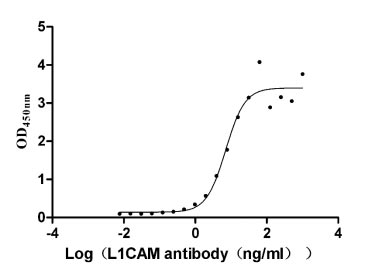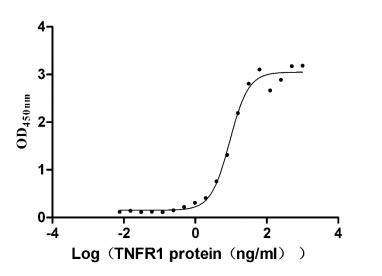Recombinant Rat Alpha-1A adrenergic receptor (Adra1a), partial
-
货号:CSB-YP001385RA1
-
规格:
-
来源:Yeast
-
其他:
-
货号:CSB-EP001385RA1
-
规格:
-
来源:E.coli
-
其他:
-
货号:CSB-EP001385RA1-B
-
规格:
-
来源:E.coli
-
共轭:Avi-tag Biotinylated
E. coli biotin ligase (BirA) is highly specific in covalently attaching biotin to the 15 amino acid AviTag peptide. This recombinant protein was biotinylated in vivo by AviTag-BirA technology, which method is BriA catalyzes amide linkage between the biotin and the specific lysine of the AviTag.
-
其他:
-
货号:CSB-BP001385RA1
-
规格:
-
来源:Baculovirus
-
其他:
-
货号:CSB-MP001385RA1
-
规格:
-
来源:Mammalian cell
-
其他:
产品详情
-
纯度:>85% (SDS-PAGE)
-
基因名:
-
Uniprot No.:
-
别名:Adra1a; Adra1c; Alpha-1A adrenergic receptor; Alpha-1A adrenoreceptor; Alpha-1A adrenoceptor; Alpha-1C adrenergic receptor
-
种属:Rattus norvegicus (Rat)
-
蛋白长度:Partial
-
蛋白标签:Tag type will be determined during the manufacturing process.
The tag type will be determined during production process. If you have specified tag type, please tell us and we will develop the specified tag preferentially. -
产品提供形式:Lyophilized powder
Note: We will preferentially ship the format that we have in stock, however, if you have any special requirement for the format, please remark your requirement when placing the order, we will prepare according to your demand. -
复溶:We recommend that this vial be briefly centrifuged prior to opening to bring the contents to the bottom. Please reconstitute protein in deionized sterile water to a concentration of 0.1-1.0 mg/mL.We recommend to add 5-50% of glycerol (final concentration) and aliquot for long-term storage at -20℃/-80℃. Our default final concentration of glycerol is 50%. Customers could use it as reference.
-
储存条件:Store at -20°C/-80°C upon receipt, aliquoting is necessary for mutiple use. Avoid repeated freeze-thaw cycles.
-
保质期:The shelf life is related to many factors, storage state, buffer ingredients, storage temperature and the stability of the protein itself.
Generally, the shelf life of liquid form is 6 months at -20°C/-80°C. The shelf life of lyophilized form is 12 months at -20°C/-80°C. -
货期:Delivery time may differ from different purchasing way or location, please kindly consult your local distributors for specific delivery time.Note: All of our proteins are default shipped with normal blue ice packs, if you request to ship with dry ice, please communicate with us in advance and extra fees will be charged.
-
注意事项:Repeated freezing and thawing is not recommended. Store working aliquots at 4°C for up to one week.
-
Datasheet :Please contact us to get it.
相关产品
靶点详情
-
功能:This alpha-adrenergic receptor mediates its action by association with G proteins that activate a phosphatidylinositol-calcium second messenger system. Its effect is mediated by G(q) and G(11) proteins. Nuclear ADRA1A-ADRA1B heterooligomers regulate phenylephrine (PE)-stimulated ERK signaling in cardiac myocytes.
-
基因功能参考文献:
- Chronic stress (water avoidance stress) animals present high levels of urinary noradrenaline, and we find the bladder dysfunctions in these animals are mediated by alpha 1A adrenoceptors, as Silodosin administration prevents the appearance of these alterations. PMID: 28569366
- effects of female sexual hormones on the expression and function of alpha1A- and alpha1D-adrenoceptor subtypes in the late-pregnant rat myometrium PMID: 26593425
- These findings indicated that noradrenaline activates alpha1-adrenoceptors, which were found to be the main receptors in Ca(2+)-related cell homeostasis and protein (including mucin) secretion in rats lacrimal glands. PMID: 26700590
- Silodosin, a selective alpha(1A)-adrenoceptor antagonist, improves voiding behavior in rat models with BOO by inducing recovery of bladder blood flow. PMID: 26189024
- Within 2 weeks of a burn, Adra1 expression increased in the re-forming epidermis, in dense bands of spindle-shaped cells in the upper dermis and on nerve fibres in the deep dermis. Adra1 expression in the upper dermis decreased contralateral to the burn. PMID: 25630693
- CXCR4 and ACKR3 modulate alpha1-AR reactivity in vascular smooth muscle and regulate hemodynamics in normal and pathological conditions PMID: 25032954
- Our data suggest that PKCalpha, beta and epsilon activation may underlie physiological and pathophysiological responses of alpha1-AR signaling for the phosphorylation of membrane-associated substrates including ion-channel and transporter proteins. PMID: 26277396
- heteromeric receptor complexes between alpha1A-AR and CXCR4 and between alpha1B-AR and CXCR4 are constitutively expressed in rat and human vascular smooth muscle cells; the quaternary structure of the receptor complex is important for signaling and contraction PMID: 25775528
- Data suggest an important role of alpha1 adrenoceptor autoimmunity in the pathogenesis and management of hypertension especially in those harboring high alpha1-AA levels. PMID: 24950619
- In conclusion, Gq protein-coupled alpha1 adrenergic receptors evoke pMF, but they are not necessary for AIH-induced pLTF. PMID: 24526581
- Our findings indicate that IC noradrenergic neurotransmission acting through activation of both alpha1- and alpha2-adrenoceptors has a facilitatory influence on pressor response to acute restraint stress. PMID: 24404141
- In the frontal cortex during sleep deprivation, adrenergic alpha1 receptor mRNA levels were reduced. PMID: 23916734
- This study demonistrated that expression of alpha(1)-adrenergic receptors in rat prefrontal cortex and collozation with 5-HT(2A) receptors. PMID: 23195622
- Local alpha-1 adrenergic receptors control dopamine transmission in the medial nucleus accumbens shell and behavioral responses to drugs of abuse. PMID: 22588352
- Both alpha1- and beta1-adrenoceptors in the bed nucleus of the stria terminalis are involved in the expression of conditioned contextual fear PMID: 22506532
- Hypothermia attenuates alpha1-adrenoceptor-mediated contraction or decreases Phe sensitivity and effective maximal vasocontraction. PMID: 22504059
- The noradrenergic component of the action of antidepressant agents plays an essential role in the modulation of alpha1A-adrenoceptor subtype in the rat cerebral cortex. PMID: 22358083
- Presynaptic alpha1-adrenoreceptors (alpha1-AR) activation modulates glutamatergic inputs that affect ventral tegmental area-dopamine neuronal excitability. PMID: 22542873
- Transcriptionally, however, second window preconditioning is considerably more complex than alpha(1A)-TG preconditioning PMID: 22307672
- Expression of alpha1-adrenoceptors on C- and delta-nociceptive afferent fibers provides a histochemical substrate for direct excitation of these fibers by adrenergic agonists. PMID: 21182905
- alpha- and beta-adrenergic signalling has a role in epinephrine-dependent control of glucose metabolism in white adipose tissue PMID: 22302710
- The alpha(1)-adrenergic stimulation releases Rem1 inhibition of voltage-gated L-type calcium channels through direct phosphorylation of Rem1 at Ser18 by protein kinase D1, resulting in an increase of the channel activity and transverse-tubule expression. PMID: 22076634
- NOX2 activated by alpha1-adrenoceptors modulates hepatic metabolic routes stimulated by beta-adrenoceptors PMID: 21958220
- Fructose intake raised the contribution of alpha1A-adrenoceptor subtype in mediating adrenergically induced vasoconstriction. PMID: 21373947
- CREB-mediated expression of alpha1 adrenoceptor contributes to TBI-associated working memory dysfunction, and therapies aimed at reducing alpha1 signaling may be useful in the treatment of TBI-associated WM deficits in humans. PMID: 20974230
- The noradrenaline-mediated depolarization of vascular smooth muscle cells is produced by activation of both alpha(1)-and alpha(2)-adrenoceptors. PMID: 20739228
- Ca(2+) entry via the Adra1a-Snapin-TRPC6-pathway plays an important role in physiological regulation of cardiac contractility and may be an important target for augmenting cardiac performance. PMID: 21546445
- Adrenergic alpha1 receptor mediates contractions of thoracic aorta by transactivation of epidermal growth factor receptor. PMID: 20977469
- Results show that microinjection of noradrenaline into the accumbens of conscious rats activates local alpha-adrenoceptors, evoking pressor and bradycardic responses, which are mediated by vasopressin release. PMID: 21535246
- Supraspinal alpha(1A)- and alpha(1D)-adrenergic receptors are apparently important for the regulation of reflex-bladder activity in conscious rats. PMID: 20668103
- alpha(1)-AR agonists contribute to hypertrophic remodelling of cardiac myocytes PMID: 19685172
- There was a functional coexistence of alpha(1A)- and alpha(1D)-adrenoceptors in the renal vasculature of spontaneously hypertensive rats irrespective of the presence of diabetic nephropathy. PMID: 19844130
- The alpha 1A-adrenoceptor subtype is specifically involved in the mechanism of action of classical antidepressant treatments (electroconvulsive shock and repeated imipramine). PMID: 12063075
- cloning and characterization of promoter and demonstration of cell specificity and regulation by hypoxia PMID: 12471020
- known second messenger, mitogenic, and transcriptional effects of alpha1A-adrenergic receptors in PC12 cells all require G protein activation. PMID: 12724349
- gene expression of alpha(1A)-AR is increased in the prostate of diabetic rats PMID: 12784082
- Results suggest that the uterine smooth muscle contraction increase caused by serotonin is mediated by adrenergic alpha(1A) receptors. PMID: 12837924
- alpha1-adrenergic activation of gene expression in cardiac myocytes is regulated by Vgl-4 PMID: 15140898
- Data suggest that alpha(1)-adrenoceptor stimulation reduces the amplitude of the I(to) by activating a G(alphas) protein and the cAMP/PKA signaling cascade, which in turn leads to I(to) channel phosphorylation. PMID: 15496483
- alpha1-adrenoceptors mediate increases in glucose uptake in L6 muscle cells. PMID: 15550506
- Human ureter was endowed with each alpha1 AR subtype, although alpha1D and alpha1A ARs were prevalent over alpha1B ARs. PMID: 15690361
- Hsp72 increases in the circulation via an alpha1-adrenergic receptor-mediated signaling pathway PMID: 16037404
- three subpopulations of alpha1-adrenoceptor binding sites exist in the rat lung (alpha1A, alpha1B and alpha1D) PMID: 16308429
- These results indicate that RGS2 is an important negative-regulatory factor in cardiac hypertrophy produced by alpha1-adrenergic receptor stimulation through mechanisms involving the modulation of mitogen-activated protein kinase signaling pathways. PMID: 16517124
- This study suggests that: (i) alpha(1A) and alpha(1D)-adrenoceptor subtypes mediate vasoconstriction of perfused rat kidney. Ageing significantly decreases alpha1-adrenoceptor-mediated vasoconstriction of rat kidney. PMID: 17199872
- This study indicates the alpha1-adrenergic receptor subtype mediates adrenergic augmentation of the activation of sensory nerves by purinergic P2X3 receptors (respond to ATP) in the periphery. PMID: 17512257
- Akap1 signaling complex mediates Adra1a-induced cardiomyocyte hypertrophy. PMID: 17537920
- These results indicate that alpha 1-adrenergic stimulation of intracellular Ca2+ activity is mediated selectively by the alpha 1A-AR. PMID: 17588332
- alpha(1)-AR in afferent cell bodies in the spiral ganglion pointed to type I afferent dendrites as a possible neural source of alpha(1)-AR beneath the inner hair cell. PMID: 17671986
- RT-PCR studies indicated differential distribution of all ADRA1A-related splice variants as well as ADRA1B and ADRA1D mRNAs, in tissues from rhesus and human male reproductive tract. PMID: 18204069
显示更多
收起更多
-
亚细胞定位:Nucleus membrane; Multi-pass membrane protein. Cell membrane; Multi-pass membrane protein. Cytoplasm. Membrane, caveola.
-
蛋白家族:G-protein coupled receptor 1 family, Adrenergic receptor subfamily, ADRA1A sub-subfamily
-
组织特异性:Abundant in heart, brain, aorta, vena cava, vas deferens, submaxillary gland, lung, and kidney. Found at lower levels in prostate, parotid gland and skeletal muscle.
-
数据库链接:
KEGG: rno:29412
STRING: 10116.ENSRNOP00000012736
UniGene: Rn.9991
Most popular with customers
-
Recombinant Human Neural cell adhesion molecule L1 (L1CAM), partial (Active)
Express system: Mammalian cell
Species: Homo sapiens (Human)
-
Recombinant Human Tumor necrosis factor receptor superfamily member 1A (TNFRSF1A), partial (Active)
Express system: Mammalian cell
Species: Homo sapiens (Human)
-
Recombinant Human Claudin-9 (CLDN9)-VLPs (Active)
Express system: Mammalian cell
Species: Homo sapiens (Human)
-
Recombinant Human Urokinase-type plasminogen activator(PLAU) (Active)
Express system: Mammalian cell
Species: Homo sapiens (Human)
















